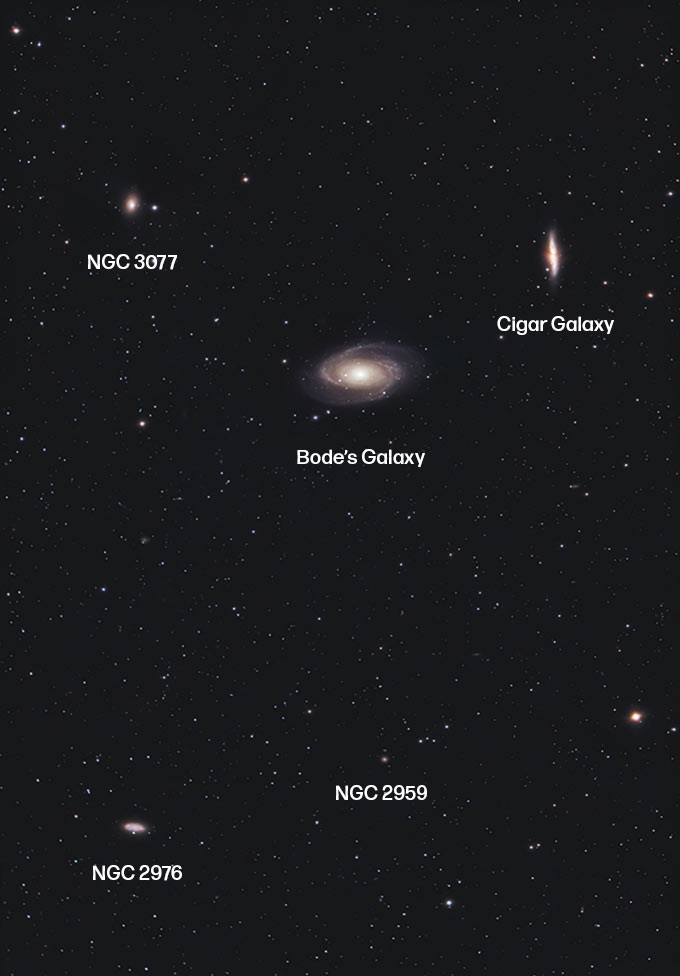M81 and M82
The M81 and M82 galaxies are a pair of galaxies located in the constellation, Ursa Major. M81 (Bode’s Galaxy) is a spiral galaxy that lies approximately 11.8 million light-years away, while M82 (The Cigar Galaxy) is an irregular galaxy at roughly the same distance away from Earth.
These galaxies have a gravitational lock on each other and have affected the shape and composition of one another. Between M81 and M82, you’ll find the Integrated Flux Nebula, but this is extremely faint and difficult to photograph. Bode’s Galaxy and the Cigar Galaxy are members of the M81 Group of galaxies.
The photo below was captured from my backyard in the city (Bortle Scale Class 6) using a Celestron RASA 8 F/2 telescope. The total integrated exposure time is 6 hours and 26 minutes.
The M81 and M82 Galaxies in Ursa Major.
They are relatively easy to find with binoculars when you start at the Big Dipper. Bode’s Galaxy and the Cigar Galaxy are often photographed as a pair by amateur astrophotographers. It is rare to have two bright, large galaxies within the same field of view.
Related Article: The Brightest Galaxies in the Night Sky
Over the years, I have photographed the M81 and M82 Galaxies using a number of different telescopes and cameras. The version shown above and was photographed using a ZWO ASI294MC Pro (One-Shot-Color) dedicated astronomy camera.
“Broadband” color astrophotography targets are difficult targets to capture when shooting in city light pollution. This is because the glow of artificial lighting is recorded in your image along with the galaxy. To help combat this, I used an Optolong L-Pro filter to reduce the known sources of man-made light in my images.
The telescope used for my image of M81 and M82 (Celestron RASA 8 F/2).
M81 and M82 – Bode’s Galaxy and the Cigar Galaxy
M81 – Bode’s Galaxy
Also cataloged as NGC 3031, Bode’s Galaxy is a spiral galaxy about 10 degrees northwest of the star, Dubhe. Using a telescope with a large aperture, it is possible to reveal the spiral structure of M81 under dark skies.
Bode’s Galaxy has a diameter of 90,000 light-years, which is about half of the size of our own Milky Way Galaxy. A supernova was detected in Messier 81 on March 28th, 1993. At the time of discovery, SN 1993J was the second brightest supernova observed in the 20th century.
- Object Type: Spiral Galaxy
- Constellation: Ursa Major
- Distance: 11.8 million light-years
- Apparent Magnitude: 6.9
- Apparent Dimensions: 26′.9 x 14′.1
M82 – The Cigar Galaxy
In the winter of 2020, I photographed the M82 Galaxy in h-alpha to add dramatic details to my existing color image of the Cigar Galaxy. I used a monochrome CCD camera (Starlight Xpress Trius 694) with an Astronomik 6nm Ha filter to isolate the hydrogen elements of this target.
To build the image, I carefully blended the h-alpha details captured using the monochrome camera with my existing color data captured in broadband RGB. This added a subtle layer of texture to the Cigar Galaxy and its unique starburst appearance.
Messier 82 – The Cigar Galaxy.
The image above includes over 7 hours of exposure time collected in broadband RGB and 55 minutes in h-alpha.
The Cigar galaxy is an irregular galaxy (or starburst galaxy) that lies only 38 arc-minutes from M81 when viewed from Earth. This galaxy appears as a “rod of light” in modest telescopes, while larger telescopes will reveal the dark patches across the surface.
The starburst activity in M82 is thought to have been triggered by interacting with M81 over millions of years. An interesting story about M82 is the unknown radio waves that were detected from this galaxy in 2010 by the Jodrell Bank Observatory.
- Object Type: Irregular Galaxy/Starburst Galaxy
- Constellation: Ursa Major
- Distance: 11.4 – 12.4 million light-years
- Apparent Magnitude: 8.4
- Apparent Dimensions: 11′.2 x 4′.3
From the northern hemisphere, this galactic pair is best observed in the spring. In March 2020, I photographed the M82 Galaxy from my backyard using a camera and telescope.
In the video below, you’ll see the results of my efforts in the backyard:
Results with a DSLR and Telescope
A stock (non-modified) DSLR camera is more than capable of capturing a fascinating portrait of the M81 and M82 Galaxies. For the image below, I attached a Canon EOS Rebel Xsi digital camera to my Newtonian reflector telescope using a t-ring adapter for an up-close look at M81 and M82.
The focal length of the telescope is 800mm, which is wide enough to fit both objects, yet enough magnification to reveal fascinating details in both galaxies. The Orion 8″ F/3.9 Newtonian Astrograph is a popular choice for amateur astrophotographers looking to collect a lot of signal in a single exposure.
If you want to photograph M81 and M82 using a camera and telescope, I suggest using a focal length of at least 800mm or more. This magnification is needed to record the delicate details of each galaxy.
It is tempting to shoot these targets using a wide field of view, because the area contains many other galaxies such as NGC 3077, and NGC 2976. However, expect a loss of detail in your primary subjects (M81, M82) using a shorter focal length.
The image below was captured using a telescope with a focal length of 400mm, for an exceptionally wide look at the area of sky where Bode’s Galaxy and the Cigar Galaxy reside.
Galaxies in Ursa Major.





